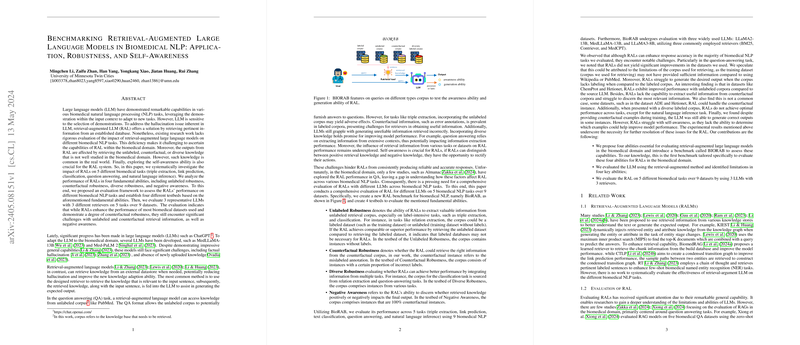Evaluating Biomedical Applications of Retrieval-Augmented LLMs
Introduction
In the world of biomedical NLP, LLMs like ChatGPT have demonstrated powerful capabilities. However, they are prone to issues like factual hallucinations—generating information that appears plausible but is actually incorrect. This paper explores a promising approach to mitigate this problem: Retrieval-Augmented LLMs (RALs), which enhance LLMs by fetching relevant information from external databases.
The Basics of RALs
Imagine you're using an LLM to extract biomedical information. Instead of relying solely on its pre-trained knowledge, a Retrieval-Augmented LLM can search an external source—like a specialized database or corpus—for pertinent information. This retrieved data, when combined with the model's input, helps generate more accurate outputs.
Tasks Studied
The evaluation focuses on five key biomedical NLP tasks:
- Triple Extraction
- Link Prediction
- Text Classification
- Question Answering (QA)
- Natural Language Inference (NLI)
The paper also systematically explores various capabilities of RALs including their robustness to unlabeled data, counterfactual data, diverse datasets, and their awareness of negative examples.
Key Findings
Robust Performance in Triple Extraction and Classification
The paper reports strong performance gains when using RALs for triple extraction and classification tasks. For instance, in the ChemProt dataset, RALs boosted the original LLM's F1 score by 49%, reaching an impressive 86.91% with the Contriver retriever.
The Curious Case of Question Answering
Interestingly, the paper finds that RALs perform worse on the question-answering task compared to traditional LLMs. This is attributed to the limited scope of the retriever corpus used in the paper, which did not access extensive biomedical databases like PubMed. The lesson here: the effectiveness of a retriever largely depends on the richness of the external data source.
Robustness Analysis
The paper introduces a comprehensive evaluation framework, BioRAB, to test the abilities of RALs. Here are the four testbeds they used:
- Unlabeled Robustness: Can RALs perform well with unlabeled retrieval corpus?
- Counterfactual Robustness: How well do RALs handle mislabeled data?
- Diverse Robustness: Can RALs benefit from diverse datasets across different tasks?
- Negative Awareness: Can RALs identify and handle harmful (negative) information?
Some Mixed Results
- Unlabeled Robustness: RALs showed dependency on labeled data, especially for label-intensive tasks. However, in datasets like ChemProt, they still outperformed the original LLMs even with an unlabeled corpus.
- Counterfactual Robustness: Higher rates of mislabeled data adversely impacted RAL performance, but lower levels (20%) seemed manageable.
- Diverse Robustness: Using datasets from different tasks offered mixed results—sometimes beneficial, but often treated as noise.
- Negative Awareness: The RALs struggled with identifying harmful information from negative examples, a crucial area needing further research.
The Implications
Practical Applications
The insights from this paper have significant implications for clinical applications and biomedical research. RALs can potentially transform tasks like patient record analysis, clinical decision support, and drug interaction studies by providing more accurate information—so long as the retrievers are adept at fetching and the corpora are rich and diverse.
Theoretical Implications
From a theoretical standpoint, this research highlights the challenges in making LLMs more robust and reliable. The struggle with counterfactual and diverse data corpuses suggests that the design of retrievers and the quality of input corpora are pivotal in RALs' effectiveness.
Future Directions
Improving the retrieval process—especially expanding corpora for question answering and other tasks—appears to be the next logical step. Moreover, enhancing the models' self-awareness abilities to discern between useful and misleading information will be crucial for the widespread application of RALs in sensitive domains like biomedical research.
Overall, this paper provides valuable insights into the capabilities and limitations of retrieval-augmented LLMs in the biomedical domain, illuminating paths for future advancements.
